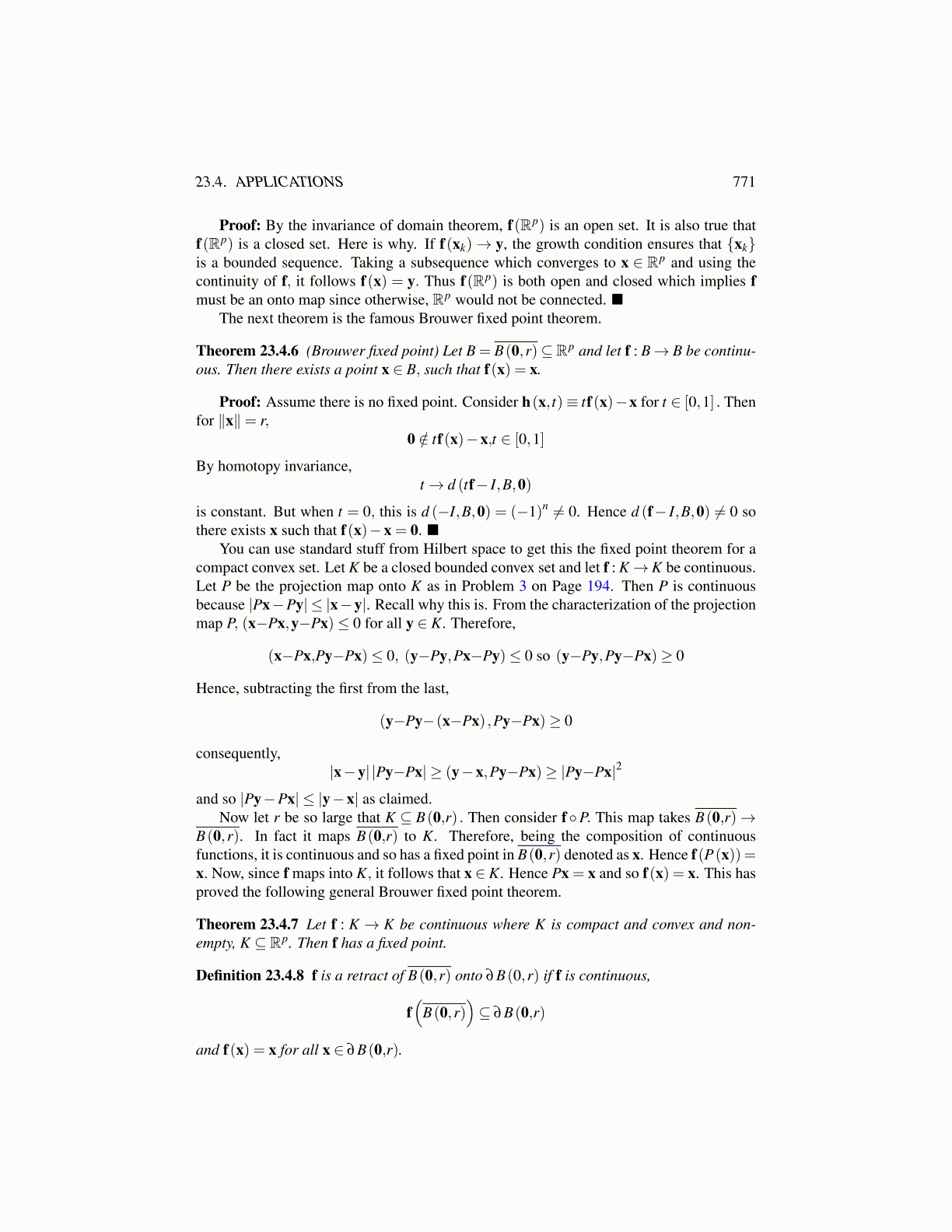
23.4. APPLICATIONS 771
Proof: By the invariance of domain theorem, f(Rp) is an open set. It is also true thatf(Rp) is a closed set. Here is why. If f(xk)→ y, the growth condition ensures that {xk}is a bounded sequence. Taking a subsequence which converges to x ∈ Rp and using thecontinuity of f, it follows f(x) = y. Thus f(Rp) is both open and closed which implies fmust be an onto map since otherwise, Rp would not be connected.
The next theorem is the famous Brouwer fixed point theorem.
Theorem 23.4.6 (Brouwer fixed point) Let B = B(0,r)⊆Rp and let f : B→ B be continu-ous. Then there exists a point x ∈ B, such that f(x) = x.
Proof: Assume there is no fixed point. Consider h(x, t)≡ tf(x)−x for t ∈ [0,1] . Thenfor ∥x∥= r,
0 /∈ tf(x)−x,t ∈ [0,1]
By homotopy invariance,t→ d (tf− I,B,0)
is constant. But when t = 0, this is d (−I,B,0) = (−1)n ̸= 0. Hence d (f− I,B,0) ̸= 0 sothere exists x such that f(x)−x = 0.
You can use standard stuff from Hilbert space to get this the fixed point theorem for acompact convex set. Let K be a closed bounded convex set and let f : K→K be continuous.Let P be the projection map onto K as in Problem 3 on Page 194. Then P is continuousbecause |Px−Py| ≤ |x−y|. Recall why this is. From the characterization of the projectionmap P, (x−Px,y−Px)≤ 0 for all y ∈ K. Therefore,
(x−Px,Py−Px)≤ 0, (y−Py,Px−Py)≤ 0 so (y−Py,Py−Px)≥ 0
Hence, subtracting the first from the last,
(y−Py−(x−Px) ,Py−Px)≥ 0
consequently,|x−y| |Py−Px| ≥ (y−x,Py−Px)≥ |Py−Px|2
and so |Py−Px| ≤ |y−x| as claimed.Now let r be so large that K ⊆ B(0,r) . Then consider f ◦P. This map takes B(0,r)→
B(0,r). In fact it maps B(0,r) to K. Therefore, being the composition of continuousfunctions, it is continuous and so has a fixed point in B(0,r) denoted as x. Hence f(P(x)) =x. Now, since f maps into K, it follows that x ∈ K. Hence Px = x and so f(x) = x. This hasproved the following general Brouwer fixed point theorem.
Theorem 23.4.7 Let f : K → K be continuous where K is compact and convex and non-empty, K ⊆ Rp. Then f has a fixed point.
Definition 23.4.8 f is a retract of B(0,r) onto ∂B(0,r) if f is continuous,
f(
B(0,r))⊆ ∂B(0,r)
and f(x) = x for all x ∈ ∂B(0,r).